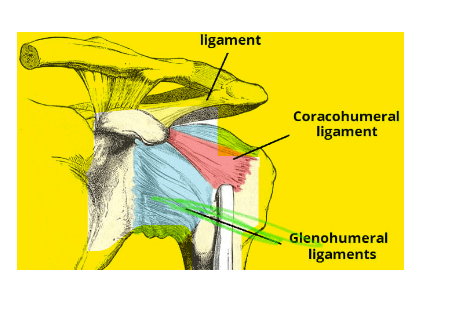Quick Overview
The Glenohumeral Ligaments are a group of ligaments located within the shoulder joint. They play a vital role in stabilizing the articulation between the head of the humerus (the upper arm bone) and the glenoid fossa of the scapula (the shoulder blade). These ligaments are integral to the complex mechanism that allows the shoulder joint to function as a highly mobile ball-and-socket joint.

Table of Contents
Anatomy of Glenohumeral Ligaments
The GH ligaments are comprised of three primary components;
- Superior Glenohumeral Ligament (SGHL): This ligament runs from the superior aspect of the glenoid fossa to the humerus. It plays a crucial role in preventing excessive external rotation and abduction of the shoulder.
- Middle Glenohumeral Ligament (MGHL): Positioned beneath the SGHL, the MGHL connects the anterior aspect of the glenoid fossa to the humerus. It contributes to anterior stability and is one of the most important ligaments for preventing dislocation.
- Inferior Glenohumeral Ligament (IGHL): The IGHL is the largest and most complex of the Glenohumeral Ligaments. It includes the anterior band (AIGHL), the posterior band (PIGHL), and the axillary pouch. The IGHL contributes significantly to shoulder stability, particularly during movements like abduction and external rotation.
GH ligament Attachments
The following table shows the attachments of the three glenohumeral ligaments;
| Ligament | Origin | Insertion |
| Superior glenohumeral ligament (SGHL) | Superior glenohumeral ligament (SGHL) | Lesser tuberosity of humerus |
| Middle glenohumeral ligament (MGHL) | Middle margin of glenoid fossa | Lesser tuberosity of humerus |
| Inferior glenohumeral ligament (IGHL) | Inferior margin of glenoid fossa | Humerus just below lesser tuberosity |
Glenohumeral Ligaments Functions
The glenohumeral ligaments work together to stabilize the glenohumeral joint and prevent excessive movement, such as dislocation. The SGHL and MGHL are primarily responsible for preventing anterior (forward) translation and inferior (downward) translation of the humeral head. The IGHL is primarily responsible for preventing anterior translation and external rotation of the humeral head.
Glenohumeral Ligaments Injury
Glenohumeral ligament injuries are common among athletes who participate in sports that involve overhead throwing or repetitive arm movements. Glenohumeral ligament injuries can also occur in people who do not participate in sports, but who frequently perform activities that involve overhead arm movements, such as painting or carpentry.
Types of Glenohumeral Ligament Injuries
The most common types of glenohumeral ligament injuries are sprains and tears. A sprain is a stretching or tearing of the ligament. A tear is a complete rupture of the ligament. Glenohumeral ligament injuries can range in severity from mild to severe.
Superior Glenohumeral Ligament (SGHL)
The SGHL is the most commonly injured of the three glenohumeral ligaments. SGHL injuries are often associated with shoulder dislocations.
Middle Glenohumeral Ligament (MGHL)
MGHL injuries are less common than SGHL injuries. MGHL injuries are often associated with shoulder instability.
Inferior Glenohumeral Ligament (IGHL)
IGHL injuries are the most common type of glenohumeral ligament injury in athletes. IGHL injuries are often associated with shoulder instability and impingement syndrome.
Symptoms of Glenohumeral Ligament Injuries
Common symptoms of glenohumeral ligament injuries include:
- Pain in the shoulder
- Swelling in the shoulder
- Decreased range of motion in the shoulder
- Instability of the shoulder
Treatment for Glenohumeral Ligament Injuries
Treatment for glenohumeral ligament injuries depends on the severity of the injury. Mild injuries may be treated with rest, ice, compression, and elevation (RICE). More severe injuries may require physical therapy or surgery.
Prevention of Glenohumeral Ligament Injuries
There are a few things you can do to prevent glenohumeral ligament injuries, including:
- Warming up before participating in physical activity
- Strengthening the muscles around the shoulder
- Using proper form when performing activities that involve overhead arm movements
- Avoiding activities that aggravate the shoulder
Questions
Q: What is the difference between a glenohumeral ligament injury and a rotator cuff tear?
The glenohumeral ligaments and the rotator cuff are both important structures that help to stabilize the shoulder joint. However, they are two different structures. The glenohumeral ligaments are located outside of the shoulder joint, while the rotator cuff muscles and tendons are located inside of the shoulder joint. Glenohumeral ligament injuries are typically caused by acute trauma, such as a fall or a dislocation. Rotator cuff tears are typically caused by overuse or degeneration.
Q: How long does it take to recover from a glenohumeral ligament injury?
The recovery time for a glenohumeral ligament injury depends on the severity of the injury. Mild injuries may heal within a few weeks, while more severe injuries may take several months to heal. If surgery is required, the recovery time can be even longer.
Q: Can I still play sports after a glenohumeral ligament injury?
Yes, you can still play sports after a glenohumeral ligament injury, but it is important to follow your doctor’s instructions and gradually return to activity. It is also important to wear a brace or other supportive device to protect your shoulder from further injury.
Q: What are the risks of surgery for a glenohumeral ligament injury?
Surgery for a glenohumeral ligament injury is generally safe and effective. However, there is a small risk of complications, such as infection, nerve damage, and stiffness. It is important to discuss the risks and benefits of surgery with your doctor before making a decision.
Q: How can I prevent a glenohumeral ligament injury?
There are a few things you can do to prevent a glenohumeral ligament injury, including:
1- Warming up before participating in physical activity
2- Strengthening the muscles around the shoulder
3- Using proper form when performing activities that involve overhead arm movements
4- Avoiding activities that aggravate the shoulder
